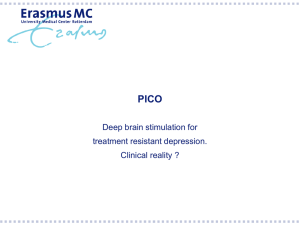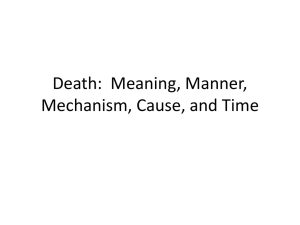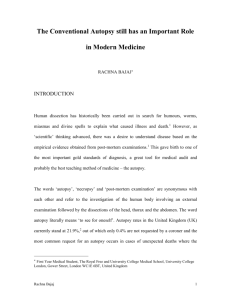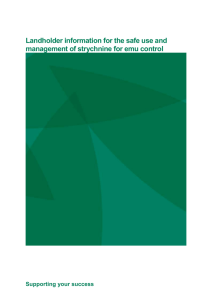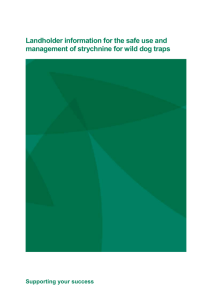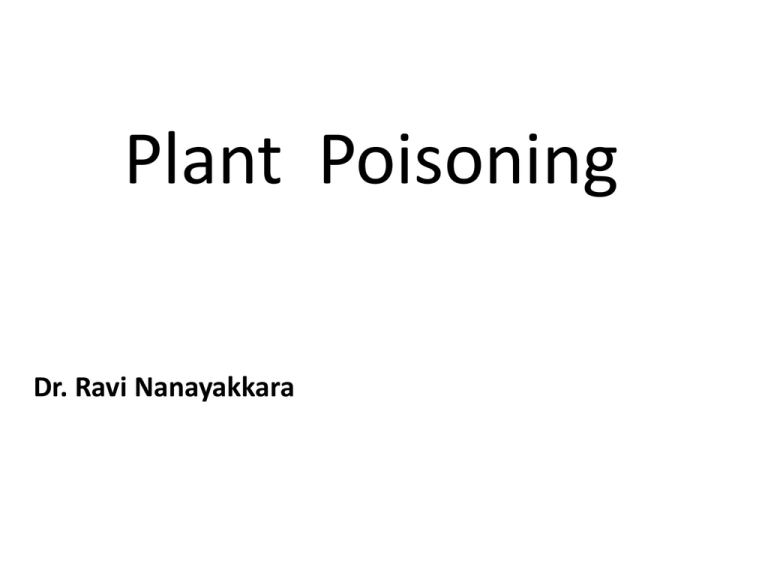
Plant Poisoning
Dr. Ravi Nanayakkara
Objectives
• Introduction, classification and identification
of poisonous plants.
• Circumstances, route of entry, metabolism
and excretion of plant poisons.
• Mechanism of action, target organs, clinical
features(early and late phase) and principles
of management.
• Autopsy features(external and internal) and
sample collection.
Plant poisoning
More than 300 poisonous plants.
Some are edible.
Act on more than one organ, but act
principally on one organ system.
Classification
•
•
•
•
Neurotoxins
Cardiac toxins
Gastrointestinal irritants
Cellular poisons
Neurotoxins
• Datura stramonium
• Substances of abuse
Canabis sativa
Erythrocylon coca
Papaver somniferum
• Strychnos Nux vomika
Cardiac toxins
• Nerium odorum
• Thevetia peruviana
Gastro intestinal irritants
• Gloria superba
• Ricinus communis
Cellular poisons
• Manihot utilissma
• Adenia palmeta
Datura stramonium
• Attana
• CNS
Toxic substances
Atropine
Hyoscine
Hyocyamine
Scopolamine
All are alkaloids
Circumstances
Accidental –Children eat the seed or fruit
Eating the leaves (mistakenly)
Intentional – for revenge, confuse an enemy
to robbery – mix with thalaguli
during long distance bus travels
Suicidal ingestion rare.
Absorption
• GIT
• Skin
• Mucous membranes
Target Organs - Atropine
• brain, heart, smooth muscles, glands
• Excretion - Kidney
Clinical features
• Shown in the table.
Organs
Pathophysiology
Clinical Features
CNS
Stimulation Followed by depression
Euphoria, delirium aggression,
terrifying hallucinations,
bizarre behaviour, confusion,
convulsions,
increased muscle tone,
Unconsciousness
Heart
Parasympathetic block — > stimulation
Tachycardia, hypertension,
Tachyarrythmias rarely
Skin
Inhibition of sweat glands, Dilatation of blood
vessels
Dry, hot Flushes
Eyes
Relaxation of radial muscles of
pupils, Inhibition of lachrymal
glands
Mydriasis and blurring of vision,
Inhibition of salivary glands ,Inhibition of
intestinal musculature leading to
relaxation
Dry mouth,
Reduced gut motility
Alimentary tract
photophobia, Dry eyes
Principles of Management
• Eliminate the poison
• Phytostigmine to reverse the action
• Diazepam to control fits
• Manage complications accordingly
Mode of death
• Respiratory paralysis Asphyxia
Postmortem finding
• Non specific
• Seeds or fragments of the plant may be found
in the stomach.stomach may show slight
inflmmation.
• Lungs : pulmonary oedema.
• Other organs will show sings of asphyxia.
Specimen collection
• Stomach and contents
• Intestine
• Urine
• Blood
Canabis sativa
• Ganja – flower
• Marijuana – flowery tops / cut leaves
• Hashish – dried resin
• H oil – oily extract
Toxic substances
• Alkaloids
• Cannabinol
• Cannabidiol
• Cannabidiolic acid
Circumstances
• Smoking
• Beverage
• With datura
Clinical features
•
•
•
•
•
•
•
Inhibitions removed – like alcohol
Confusion
Restlessness
Hallucinations
Narcosis
Nausea
Depression
Principles of management
• Symptomatic
Autopsy
• Non specific
• Features of addiction
Erythrocylon coca
• Grows in Central/South America
• Toxic Substances
• Alkaloid – cocaine
• Leaves
• Synthetic
• Action – stimulates CNS and CVS
similarly to adrenalin
Clinical features
Shown in the table.
Pathophysiology
Clinical features
CNS - Initial stimulation
Excitement, hallucinations, euphoria,
hyperkinesis, headache, nausea, vomiting,
twitching of small facial muscles, stereotype
behaviour, hypereflexia, tonic-clonic seizures
Hyporeflexia, coma, respiratory and
cardiovascular depression
Late - depression
CVS - Initial stimulation –
Late – depression
Respiratory system - Initial stimulation – Late
depression
Tachycardia, hypertension, ventricular
dysrhythmias Weak, slow pulse; low blood
pressure
Tachypnoea, slow shallow breathing,
cyanosis
Vasoconstriction, Hyperactivity (psycho-motor)
pallor, hyperthermia
Pyrogenic action on thermoregulatory centre
Sympathomimetic action on intestinal wall
Constriction of radial muscles of the pupil
Diarrhoea, abdominal cramps
Dilatation of pupil
Discussed in drugs of abuse
Papaver somniferum
(Opium / Heroin)
• Unriped capsule of poppy plant
• Alkaloids – morphine
codeine
narcolin
papavarin ……
Circumstances
• Ingestion
• Inhalation
• Injections
Clinical features
• Excitement – euphoria
• Depression of brain stem
• Narcosis and death
Discussed in drugs of abuse
Strychnos Nux vomika
Goda/Divi kaduru
•
•
•
•
Spinal stimulant
Commonly found in Southern costal area.
Toxin is mainly found in seeds.
Poison – Strychnine ( an alkaloid)
Circumstances
•
•
•
•
Accidental – Children eat fruit
Suicidal rare due to bitter
Homicidal rare due to bitter
Abstract of seeds(strychnine) is used to as a
rodenticide, kill stray dogs by injecting with a
long stick
• Homicidal injection - rare
Absorption
• All mucosal surfaces
• Rapidly absorbed via GIT and spread
throughout body
Target organ
• Spinal cord and brain
Action
• Strychnine stimulate the brain and spinal cord
by inhibiting the inhibitory pathways.
• Hyperexcitation of brain stem and spinal cord.
• Slightest stimulation can cause convulsions.
Clinical features
•
•
•
•
•
•
Bitter taste in mouth
Muscle stiffness
Tremors
Twitching
Convulsions
Concious till death
Differential diagnosis
Feature
Strychnine
Tetanus
History
Of poisoning (may be)
Injury (usually available)
Onset of symptoms
Sudden
Gradual
Early symptoms
Uneasiness, Restlessness
Lock jaw
Relaxation in between
spasms
Complete
Never complete
Fatal period
Few hours
Several days
Chemical analysis
Poison +
No poison
Management
• Maintain airway, breathing, circulation
• Control fits
• Minimum stimulation
Gastric lavarge and vomiting can
precipitate convulsion.
• Management of complications
Mode of death
• Hypoxia to brain stem
Respiratory paralysis
Asphyxia
Autopsy
• Non specific
• Asphyxia
• Muscle haemorrhages
Cardio vascular system
• Thevetia peruviana – Yellow oliander
• Nerium oleander – Pink oliander
Circumstances
• Suicide-consume fruits
• Accidental – any part of the plant (children)
• Homicidal-rare
Toxic substance
• Cardiac glycosides – digitalis like action
• Inhibit Na+/K+ ATPase
• Alteration of membrane potential in
myocardium and neurones
• Increse cardiac
Excitability
Contractility
Automaticity
Route of absorption
• GIT-injestion
Target organs
• Heart (mainly) - Arrhythmias
• CNS - Neuronal excitability depression
• GIT-irritant
Clinical features
• Faintishness,papitation,
irregular pulse,hypotensoin
• Yellow vision,blurred vision,dilated pupils,
muscular twiching,tetanic spasms,anxiety,
confusion
• Nausea,vomiting
• Pain in throat and numbness in tongue and
lips,abdominal pain,profuse salivation
Principles of management
• Emesis
• Activated charcoal
• Antidote-Kaneru tab
(Antibody against cardiac glycosides)
• Management of complications
Mode of death
• Circulatory failure
• Arrhythmias
Lethal dose : 8-10 seeds, 15-20g root
Autopsy
• Non specific
• GIT irritation
• Fragments of seed in stomach
• Poisonous part – Fruit seeds
• Poison - Cardiogenic glycosides
• Circumstances - Accidental, suicidal
• Clinical features - Cardiac arrhythmias
Gloriosa superba (Niyangala)
• Main suicidal poison before availability of
pesticides
• Grows throughout the island
Toxic substances
• Colchicine- Cellular poison
• Choline
• Salicylic acid
Mode of action
• Colchicine-cellular poison
Mitosis arrested.
Cell death.
• Choline – action same as acetyl choline
• Salicylic acid – Local irritant
Circumstances
• Accidental-yams
• Suicidal
• Homicidal
Target organs
• Gastro intestinal tract
• Bone marrow
• CNS
• Smooth muscles
Clinical features
• Shown in the table.
Patho – physiology
Symptoms and signs
Time of onset after ingestion
Acute inflammation of alimentary
tract mucosa due to local actions of
salicylic acid and benzoic acid
burning pain, numbness, itching
and tingling around mouth and
throat. Nausea, vomiting,
dehydration, thirst, blood and
mucus diarrhoea
within 6- 12 hrs
Augmentation by choline of
autonomic contraction of smooth
muscles throughout the body. In
gastrointestinal tract , bronchi ,
uterus
abdominal colic, ileus, tenesmus, within 6- 12 hrs
breathlessness
abortion
Block of mitosis, by cholchicine in
bone marrow→
bone marrow aplasia→
Throinbocytopenia
bleeding gums, easy bruising
Acute tubular necrosis of the kidney
decreased urine output,
haematuria
Central nervous system stimulation,
then depression.
Respiratory centre depression
Restlessness, confusion,
delirium, convulsions, coma
Breathlessness
after 36 hrs
Arrest of cell division in hair follicles
Alopecia, generalized depilation
after 1-2 weeks
within 6 hrs
Principles of management
• Gastric lavage
• Activated charcoal
• Management of complications
Autopsy
• Features of acute dehydration and GI irriration
• Features of complication
Ricinus communis(Endaru)
• Entire plant is poisonous
• Seeds most poisonous
• Grows throughout the island
• Absorption
GI mucosa
Mode of action
Ricin
Blockage of protein synthesis
Cell death
Tissue necrosis
Acute inflammation
Circumstances
• Accidental –Children
• Suicidal
• Homicidal-rare
Clinical features
Pathology
Clinical features
Alimentary tract
Acute inflammation
Burning, sensation of mouth, throat, chest,
abdomen, salivation, nausea, vomiting
diarrhoea
↙
↘
Dehydration
electrolyte
(thirst)
imbalance
↓
↓
shock
muscle cramps
(oliguria)
(abdomen/calves)
drowsiness, delirium, convulsions
Haemorrhagic gastroenteritis, erosions
abdominal pain,haematemesis,bloody diarrhoea
Kidney
Nephritis,
Acute renal tailure
haematuria. albuminuria. oliguria. uraemia
Liver
Necrosis. Inflammation
jaundice
Management
• Gastric lavarge
• Complication
Mode of death
• Circulatory failure
• Renal failure
• Respiratory failure
Autopsy
• GIT irritation
• Seeds in stomach
• Non specific (Oedema and foci of necrosis)
Specimen
• Gastric contents
• Blood
• Histology
Liver
Kidney
Stomach and intestine
Manihot utilisma
• Cyanogenic glycoside
Clinical features
•
•
•
•
•
Nausea
Vomiting
Abdominal pain
Diarrhoea
Respiratory failure
Management
• Complications
Autopsy
• Contents in stomach
• Non specific
Poisoning ?
• National Poisons Information Centre
National Hospital of Sri Lanka Colombo.
0112686143, 0112691111 Ext 430
Summary
•
•
•
•
CNS
GIT
CVS
Cellular toxic
Plants
•
•
•
•
•
•
•
•
Datura stramonium
Canabies sativum
Erythrocylon cocca
Papova somniferum
Strichnus nux vomica
Nerium odorum
Gloriosa superba
Ricinus communis
For each plant
•
•
•
•
•
•
•
•
•
Toxic substance
Circumstances
Absorption
Actions / target organs
Clinical features
Management
Modes of death
Post mortem findings
Samples
Thank You.


